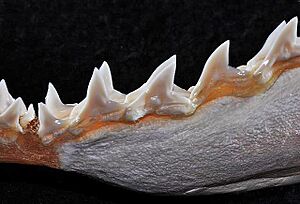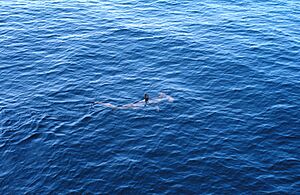Smooth hammerhead facts for kids
Quick facts for kids Smooth hammerhead |
|
|---|---|
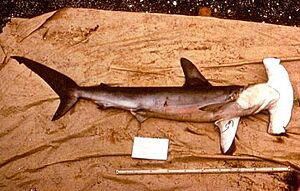 |
|
| Conservation status | |
| Scientific classification | |
| Genus: |
Sphyrna
|
| Species: |
zygaena
|
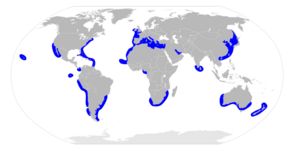 |
|
| Range of the smooth hammerhead | |
| Synonyms | |
* ambiguous synonym |
|
The smooth hammerhead (Sphyrna zygaena) is a type of hammerhead shark. It gets its name from its unique head shape. The head is flat and wide, like a hammer, but it doesn't have a dip in the middle, making it "smooth." Unlike most other hammerhead sharks, this species prefers cooler, temperate waters around the world. In summer, these sharks travel towards the Earth's poles to find cooler water. Sometimes, they swim in huge groups of hundreds or even thousands!
The smooth hammerhead is the second-largest hammerhead shark, right after the great hammerhead shark. It can grow up to 5 m (16 ft) long. This shark is an active predator, meaning it hunts other animals for food. It eats many kinds of bony fishes and small sea creatures like invertebrates. Bigger smooth hammerheads also eat other sharks and rays. Like other hammerheads, the smooth hammerhead gives birth to live young. A mother can have 20 to 40 baby sharks at once. This shark is quite common, but it is often caught by fishing boats. Its fins are very valuable for making shark fin soup. While it is a large shark, it usually stays in cooler waters. This means it is less likely to meet swimmers than other big hammerhead sharks.
Contents
About the Smooth Hammerhead Shark
The famous Swedish scientist Carl Linnaeus first described the smooth hammerhead in 1758. He called it Squalus zygaena. Later, its name was changed to Sphyrna zygaena. The word zygaena comes from a Greek word meaning "yoke". This refers to the hammer-like shape of its head. People also call this shark the common hammerhead or round-headed hammerhead.
How Smooth Hammerheads Are Related
Scientists study how different hammerhead sharks are related. The smooth hammerhead is closely related to the great hammerhead. However, it is not as closely related to the scalloped hammerhead as other Sphyrna species. Early hammerheads likely had large, wide heads, similar to the smooth hammerhead.
What Does a Smooth Hammerhead Look Like?
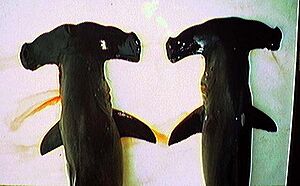
The smooth hammerhead is the second-largest hammerhead shark. It usually grows to be 2.5–3.5 m (8.2–11.5 ft) long. The biggest one ever recorded was 5 m (16 ft) long and weighed 400 kg (880 lb).
The smooth hammerhead's head is different from other large hammerheads. It has a curved front edge with no dip in the middle. This wide head makes up about 26-29% of its body length. Its nostrils are near the ends of its wide head. Long grooves run from the nostrils towards the center of the head.
This shark has many teeth. There are 26 to 32 rows of teeth in its upper jaw. Its lower jaw has 25 to 30 rows. Each tooth is shaped like a triangle. The edges of the teeth are smooth or only slightly jagged.
The smooth hammerhead has a sleek body. It does not have a ridge on its back between its two dorsal fins. The first dorsal fin is quite tall and curved like a sickle. Its tip is rounded. The pectoral and pelvic fins are not curved. They have almost straight back edges. The anal fin is bigger than the second dorsal fin. It has a long, free tip and a strong notch at the back.
The shark's skin is covered in tiny, tooth-like scales called dermal denticles. These scales are packed closely together. Each one has 5 to 7 ridges that lead to a W-shaped back edge. Young sharks have only 3 ridges. The back of the shark is dark brownish-gray or olive green. This color is different from the simple brown of most other hammerheads. Its sides are lighter, and its belly is white. Sometimes, the edges of its pectoral fins are dark underneath.
Where Smooth Hammerheads Live
The smooth hammerhead is the hammerhead shark that can handle the coolest water. It lives all over the world in higher latitudes than any other hammerhead.
In the Atlantic Ocean, you can find it from Nova Scotia to the Virgin Islands. It also lives from Brazil to southern Argentina. On the other side of the Atlantic, it is found from the British Isles to Côte d'Ivoire. This includes the Mediterranean Sea.
In the Indian Ocean, it lives off South Africa, India, and Sri Lanka. In the western Pacific Ocean, it is found from the Gulf of Tonkin to southern Japan and the Russian Far East. It also lives off Australia and New Zealand. In the central and eastern Pacific, it is found off the Hawaiian Islands, California, Panama, the Galapagos Islands, Ecuador, and Chile.
This shark usually prefers subtropical and warm temperate areas. However, it has been seen in tropical waters too, but this is rare. Smooth hammerheads have been found in water temperatures from 7.5 to 27.5 °C (45.5–81.5 °F).
Compared to other large hammerheads, the smooth hammerhead stays closer to the surface. It usually swims in water less than 20 m (66 ft) deep. But it has been seen diving as deep as 200 m (660 ft). It likes coastal waters like bays and estuaries. Sometimes, it is found in the open ocean over the continental shelf or near oceanic islands. This shark has even been reported in freshwater places, like the Indian River in Florida. In the summer, smooth hammerheads travel towards the poles to stay in cooler water. They return towards the equator in winter.
Smooth Hammerhead Life and Habits
Adult smooth hammerheads usually swim alone or in small groups. But during their yearly travels, they can gather in huge numbers. Groups of over a hundred young sharks have been seen off South Africa. Even schools of thousands have been reported off California. When the weather is hot in summer, you might see them swimming just below the surface with their dorsal fins sticking out of the water.
Young smooth hammerheads can be eaten by bigger sharks, like the dusky shark. Adult smooth hammerheads have been seen being eaten by killer whales off New Zealand.
What Smooth Hammerheads Eat
The smooth hammerhead is an active hunter. It eats many different things. Its diet includes bony fishes, rays, and other sharks (even other hammerheads). It also eats cephalopods like squid and octopus. Sometimes, it eats crustaceans like shrimp, crabs, and barnacles. They are also known to eat fish caught on fishing lines. In some places, stingrays are a favorite food. Scientists have found many stingray barbs stuck in the mouths of these sharks. One shark had 95 stingray spines!
In northern Europe, smooth hammerheads eat herring and seabass. In North America, they eat Spanish mackerel and menhaden. Off South Africa, they eat squid and small schooling fish like pilchard. Larger sharks (over 2 m (6.6 ft)) eat more smaller sharks and rays. Off Australia, squid are the most important food, followed by bony fish. There have even been rare sightings of smooth hammerheads trying to hunt dolphins.
Reproduction and Life Cycle
Like other hammerhead sharks, the smooth hammerhead gives birth to live young. After the baby sharks use up their yolk supply, a special connection forms with the mother. This is like a placenta, which gives the babies food. Females have many babies at once, usually 20 to 50 pups. They are pregnant for 10 to 11 months.
Birthing happens in shallow coastal areas, which act as nurseries. For example, Bulls Bay in North Carolina is a nursery area. The baby sharks are 50–61 cm (20–24 in) long when they are born. Females become adults when they are about 2.7 m (8.9 ft) long. Males become adults when they are 2.1–2.5 m (6.9–8.2 ft) long. Off South Africa, females are ready to mate in February and have full-term babies in November. Off eastern Australia, babies are born between January and March. Smooth hammerheads are thought to live for 20 years or even longer.
Smooth Hammerheads and Humans
Smooth hammerheads can be dangerous to humans, but encounters are rare. The International Shark Attack File has recorded 34 attacks linked to large hammerhead sharks. Only 17 of these were unprovoked, and one was fatal. However, because smooth hammerheads live in cooler waters where fewer people swim, they are likely responsible for only a small number of these attacks. Off southern California, these sharks have been known to take fish from sport fishers and divers.
Smooth hammerheads are caught by fishing boats around the world. This happens off the United States, Brazil, Spain, Taiwan, the Philippines, Australia, and western Africa. They are mainly caught using gillnets and longlines. It is hard to know exactly how many smooth hammerheads are caught. This is because they are often grouped with other large hammerheads in fishing reports.
The shark's meat is sold fresh, dried, salted, or smoked. However, it is not considered a popular food in most places. There have even been reports of people getting sick from eating it. The fins are much more valuable. They are highly prized for shark fin soup. This often leads to sharks being finned at sea, where their fins are cut off and their bodies are thrown back into the ocean. The shark's liver oil is used for vitamins. Its skin is used for leather, and other parts are used for fishmeal. This shark is also used in Chinese medicine.
Many other fisheries accidentally catch smooth hammerheads. They are also caught by people fishing for fun. Smooth hammerheads can also get tangled in shark nets that are used to protect beaches. In New South Wales, Australia, smooth hammerheads made up 50% of the sharks caught in these nets between 1972 and 1990.
Currently, the smooth hammerhead is still quite common. However, it is listed as "Vulnerable (VU)" by the World Conservation Union. This means it could become endangered if its population continues to decline. Off New Zealand, it is a protected species. In 2018, New Zealand classified the smooth hammerhead as "Not Threatened." In 2013, the smooth hammerhead and other large sharks were added to Appendix 2 of CITES. This means that international trade of these sharks, including their parts, is now regulated.
Images for kids




